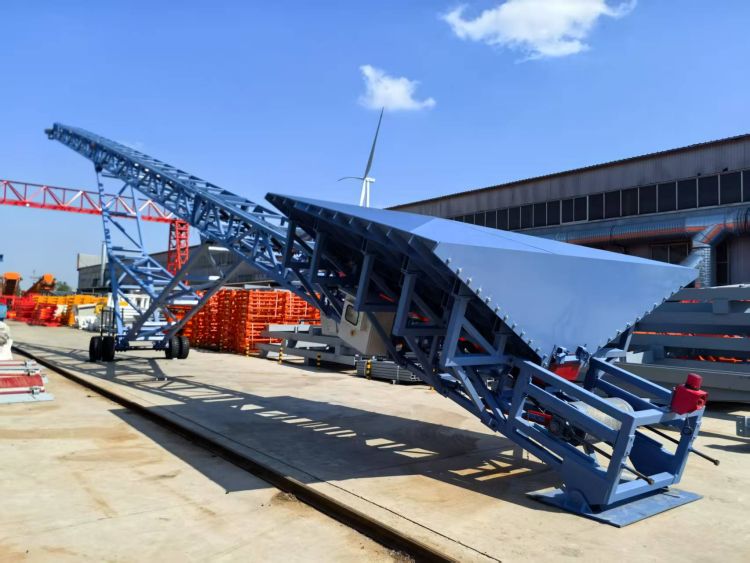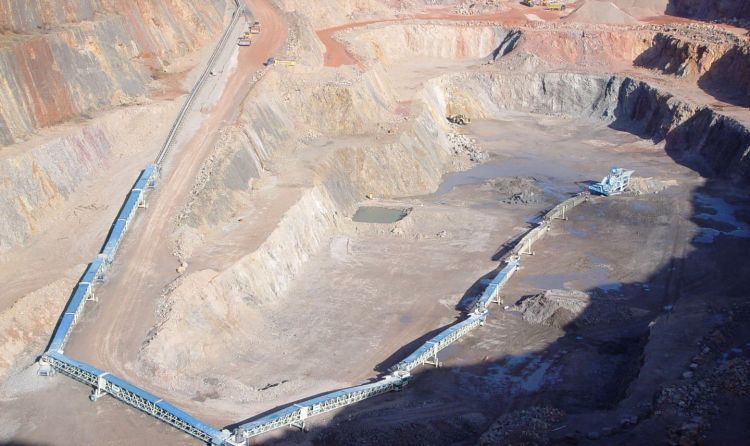Long-distance bulk material handling has always been a challenge in port operations. Traditional conveying equipment often struggles to meet the complex demands regarding flexibility, adaptability, and efficiency. While using Mobile Ship Loaders and mobile truck unloaders to transport material from stockpiles to vessels involves back-and-forth movement, it is limited by site constraints and interference from moving vehicles and personnel, and also wastes considerable unnecessary time. Therefore, the emergence of the Grasshopper Conveyor, also known as a portable conveyor or shuttle conveyor, offers an efficient solution for long-distance bulk material handling in ports with its unique design and outstanding performance.

What is a Grasshopper Conveyor
A Grasshopper Conveyor is a compact and flexible mobile stacking conveyor, primarily divided into two types: wheeled and tracked, each with its own characteristics, enabling adaptation to different port operational environments.
The Wheeled Grasshopper Conveyor features a reinforced solid chassis suitable for most terrain types found in ports, ensuring stable operation even on uneven ground. Its portable design allows for efficient transportation and is ideal for flexible movement within the limited working spaces of a port. The ultra-low receiving hopper at the tail end can be adapted to fit any model of wheel loader or excavator, facilitating rapid material loading. Furthermore, the length of the Wheeled Grasshopper Conveyor can be customized in the 15-30 meter range, making it easy to use in cascade configurations. By combining multiple units, long-distance bulk material handling becomes effortless. Additionally, the chassis can be specified with powered or unpowered wheels to meet different mobility requirements, and the option of folding or non-folding booms caters to diverse usage scenarios.
The Tracked Grasshopper Conveyor utilizes a folding boom design that occupies minimal space while extending to greater distances, beneficial for achieving long-distance conveying in the compact layouts of ports. Power options include diesel or electric drive, meeting different power supply conditions in ports. The tracked chassis grants it mobility across various terrains, whether muddy fields or rugged areas, ensuring smooth travel. The adjustable discharge height facilitates easier cascade usage and seamless integration with other conveying equipment. Like its wheeled counterpart, the Tracked Grasshopper Conveyor also employs an ultra-low receiving hopper at the tail end, adaptable to all kinds of wheel loaders and excavators. Its portable design and efficient transport capability also enable it to adapt well to limited port working spaces.
The basic model parameters of Zoomry Grasshopper Conveyors fully demonstrate their suitability for long-distance bulk material handling in ports. Taking the ZR65D model as an example, it has a handling capacity of 200 TPH, lengths selectable from 15-40 meters, conveying power of 18.5 kW, chassis power of 11 kW, inclination angle of 18 degrees, stacking height of 6.5/8.0 meters, and belt speed of 2.0 M/S. Upgrading through models like ZR80D, ZR100D, and ZR120D increases the handling capacity gradually, reaching up to 550 TPH. This ensures sufficient conveying volume while adapting to different terrains and space constraints, meeting the diverse long-distance bulk material handling requirements of ports.
How to Use Grasshopper Conveyors for Long-Distance Bulk Material Handling in Ports
To achieve long-distance bulk material handling in ports using Grasshopper Conveyors, it is necessary to comprehensively consider factors such as port site conditions, material characteristics, and conveying distance for scientific and rational system design and layout.
Regarding site planning, a detailed survey of the port's topography must be conducted first to define the scope of the operational area, ground bearing capacity, distribution of obstacles, and other conditions. Based on the survey results, the travel path and operating positions for the Grasshopper Conveyors should be planned to ensure the equipment is unimpeded during movement and operation. For Wheeled Grasshopper Conveyors, sufficient road surface smoothness must be guaranteed to avoid stability issues due to bumps; while Tracked Grasshopper Conveyors have better terrain adaptability, excessively soft areas should still be avoided to prevent sinking.
Cascade arrangement is key to achieving long-distance conveying. Determine the number of Grasshopper Conveyors required based on the conveying distance and arrange them in sequence for cascading. When setting up, ensure the discharge end of the preceding Grasshopper Conveyor aligns accurately with the receiving hopper of the next one to minimize material spillage. Simultaneously, reasonably arrange the spacing between units to allow smooth material transfer while leaving adequate space for maintenance and operation. For example, for very long distances, multiple 15-40 meter long Grasshopper Conveyors can be cascaded, forming a continuous conveying line through precise positioning and adjustment.
Different bulk materials, such as coal, ore, sand, and gravel, possess varying particle sizes, densities, moisture contents, etc. For materials with larger particle sizes and higher densities, models with stronger handling capacities, like the ZR100D or ZR120D, should be selected, and belt speed adjusted appropriately to ensure stable conveying. For materials with higher moisture content, precautions should be taken to prevent sticking and clogging during conveying; special treatments for the receiving hopper and Conveyor Belt can be applied.
Furthermore, integration with other port equipment must be considered. The Grasshopper Conveyor is not an isolated entity within a port's bulk material handling system; it needs to coordinate with equipment like trucks, vessels, and stackers. When designing the layout, ensure smooth material transfer between the Grasshopper Conveyors and these other devices, minimizing time wastage in intermediate steps. For instance, in transferring material from trucks to a vessel, Grasshopper Conveyors can be used to convey material unloaded from trucks to the ship loader, enabling efficient transfer.

Operation Process of Grasshopper Conveyors
A standardized operation process is the prerequisite for ensuring the efficient operation of Grasshopper Conveyors in long-distance port bulk material handling, and efficiency optimization through reasonable methods can further enhance conveying performance.
Before starting up, conduct a comprehensive inspection of all components of the Grasshopper Conveyor, including the tension of the conveyor belt, rotation of the idlers, oil level and pressure of the hydraulic system, and operating condition of the power system. Ensure all components are in normal working condition to prevent equipment failures from disrupting the conveying process. Also, clear any debris from the receiving hopper to ensure material enters the conveying system smoothly.
When starting, follow the correct sequence: start the power system first. Once the engine or motor runs stably, activate the conveyor belt. During startup, closely monitor the equipment operation, listen for any abnormal noises, and observe if the conveyor belt runs smoothly. If any problems are detected, stop immediately for inspection; only restart after resolving the issue.
During material conveying, control the loading volume to prevent overloading. Overloading not only increases equipment load, affecting service life, but can also cause material spillage, reducing efficiency. Operators should rationally control the unloading speed of the loader or excavator based on the Grasshopper Conveyor's handling capacity, ensuring material enters the receiving hopper evenly. Simultaneously, constantly monitor the running status of the conveyor belt, promptly clean any debris on it, and prevent material from sticking to the belt and hindering conveying.
When shutting down, first stop material loading. After all material on the conveyor belt has been discharged, turn off the conveyor belt followed by the power system sequentially. After shutdown, clean and maintain the equipment: remove residual material from the conveyor belt and receiving hopper, check wear on all components, and lubricate parts requiring it to prepare for the next operation.
Efficiency Optimization Process
Reasonably adjusting the conveyor belt speed is an effective way to boost efficiency. While ensuring stable material conveying, appropriately increasing the belt speed can increase the material handling volume per unit time. However, the speed should not be too high, as this can cause material spillage and accelerate equipment wear. The optimal belt speed can be determined through testing based on material characteristics and conveying distance.
When using cascade conveying, ensure coordination and cooperation between the Grasshopper Conveyors. A unified control system enables synchronous operation of multiple units, preventing material pile-up or conveyance interruptions due to inconsistent speeds between machines. Zoomry Grasshopper Conveyors can be equipped with PLC automatic control systems for intelligent operation and collaborative running, further improving conveying efficiency.
Additionally, regular equipment maintenance is vital for enhancing efficiency. Timely replacement of worn components like idlers and conveyor belts ensures good operating condition and reduces downtime caused by failures. Simultaneously, regular inspection and debugging of hydraulic and power systems guarantee stable performance.
If you have any questions about using Grasshopper Conveyors for long-distance bulk material handling in ports, please contact us using the information below.
- Zoomry Heavy Industries Website
- +86 131-6401-6717
- oversea@zoomry.cn
Advantages of Grasshopper Conveyors in Application
In terms of advantages, high flexibility is a prominent feature of the Grasshopper Conveyor. The designs of both wheeled and tracked types allow for flexible movement in the complex terrain of ports, adapting to various operating environments. The portable design and options for folding booms facilitate equipment transport, storage, and rapid deployment and adjustment within the limited space of a port.
Compared to traditional conveying equipment, the Grasshopper Conveyor effectively reduces material loss during long-distance conveying. Its enclosed conveying path and rational discharge design minimize material spillage and dust emission during handling, improving material utilization. Meanwhile, the efficient transport capability of the Grasshopper Conveyor reduces material turnover time in ports, enhancing overall logistics efficiency.
Zoomry's Grasshopper Conveyors also offer excellent compatibility, enabling seamless integration with existing port conveying and handling equipment like truck unloaders and mobile ship loaders. This reduces the cost of equipment replacement and modification, forming a complete bulk material handling system to help ports quickly improve bulk conveying efficiency.
Regarding reliability assurance, Zoomry Heavy Industries enforces strict quality control in the production of its Grasshopper Conveyors. The equipment employs high-quality raw materials and components, such as chassis and frames made of premium steel, and hydraulic components and power systems from well-known brands, ensuring equipment strength and durability.
The company possesses a comprehensive quality testing center, including chemical labs, hardness labs, idler labs, and mechanical performance testing labs, equipped with over 60 testing instruments. All Grasshopper Conveyors undergo rigorous testing before leaving the factory to ensure their performance meets relevant standards and certifications, such as ISO 9001 Quality Management System and ISO 14001 Environmental Management System requirements.
Moreover, Zoomry Heavy Industries provides extensive after-sales service, offering port customers technical support, spare parts supply, equipment overhaul, and upgrade services. A professional technical team responds promptly to customer needs, solving problems encountered during equipment operation, ensuring sustained and stable running. Over the years, Zoomry has provided technical consultations and services thousands of times to nearly 200 users, winning widespread acclaim from clients.

 ZOOMRY
ZOOMRY

